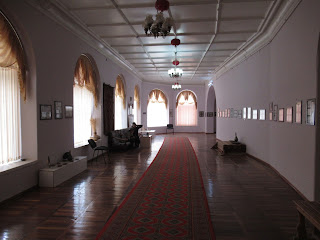Our four night stay at the hotel in Bukhara, Uzbekistan, turned out to be a great choice because of the very friendly hosts and an ideal location just steps away from the central historic square which in turn meant easy access to superb shopping and restaurants.
Throughout our stay, I spent quite a bit of time helping the owner's 21 year old son, Xurshid, with his English as he hoped to attend graduate school in the US following his graduation with an engineering degree.
After getting the shopping out of the way, we walked to the Bukhara Fine Arts Museum where we were reminded that Bukhara is one of the oldest cities in Central Asia at over 2,500 years old. According to estimates in 1910, the city's population then was 150,000 and there were 364 mosques, 2 synagogues and more than 50 bazaars! More than 140 of the city's Muslim monuments have been restored.
The museum was located in the former state bank that was built in 1912 above an ancient branch of the canal that runs through town. It seemed initially that we'd be in and out of the museum in just a few minutes as we only saw some ceramic items and a collection of black and white photos.
An old but lovely suzani adorned one wall.
The tag said this photo showed the aftermath of Bukhara being bombed in early September of 1920.
An employee gestured us to follow her outside and into an annex building where several walls were covered from top to bottom with paintings for sale. One of the artists was there hoping we might buy something but we had to smile and say no. Something that big would NOT fit into our suitcases!
As much as I enjoyed looking at the local painters' works, I admired the pretty alabaster-designed columns even more. The ticket taker was also the guide/guard/and keeper of the keys as the annex building had been closed before we arrived.
What a shame it was that there wasn't the talent, money or pride necessary to display the artists' work properly. So many of the frames were in horrific shape that I felt badly for the artists whose efforts were not respected.
A piece that looked like it came straight of a museum in India was this 7th century mural painting of Red Hall in Varakhsha.
Works in the museum mostly comprised the pre-Soviet and the Soviet era.
I found a few of the paintings to be quite pleasing. Right away I recognized Pavel Benkov's 1929 painting of Lyab-i-Hauz or stepped pool and the Khoja Zayniddin Mosque from the central square. Benkov who played an important role in Bukhara's artistic scene from the 1920s through the 1940s, tried to reflect the original history and the life of Uzbeks in his historical canvases and portraits.
His Bukhara Official was painted in 1929.
Having read so much of the country's history with cotton farming, I was struck by this 1954 painting called Evening in the Cotton Field by N. Karakhan.
It was quite a stretch to call Bukhara's gallery a 'Fine' Art Museum because of the poor quality of its installations. However, we were glad we'd made the effort to discover another facet of the historic Silk Road City that we had come to find really special.
Steven had previously gone to the train station to buy tickets theoretically on the express train to Samarkand, the last of the Silk Road cities in Uzbekistan we'd be touring. It was only when we boarded the swanky train we realized our tickets were for the much slower and older train, however! By the way, the city is known in Uzbek as Buxoro in case you noticed the name atop the train station.
Even from our cheap seats we had nice views of the setting sun as we left Bukhara.
Our travel companions on the two and a half hour journey!
Next post: Exploring Samarkand.
Posted on a not so spooky Halloween, 2018, from Roses in Costa Brava in far northeastern Spain!

































No comments:
Post a Comment